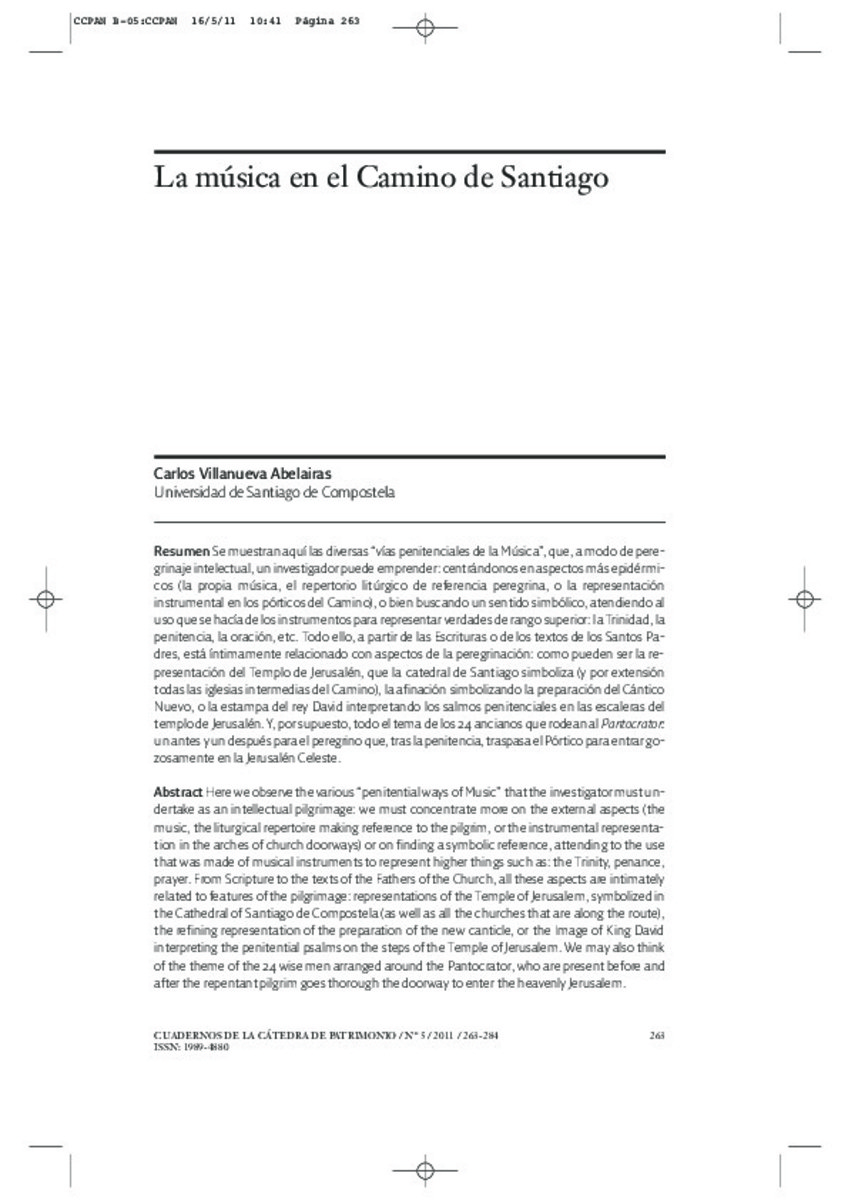Full metadata record
| DC Field | Value | Language |
|---|---|---|
| dc.creator | Villanueva-Abelairas, C. (Carlos) | - |
| dc.date.accessioned | 2015-06-09T09:35:30Z | - |
| dc.date.available | 2015-06-09T09:35:30Z | - |
| dc.date.issued | 2011 | - |
| dc.identifier.citation | Villanueva-Abelairas, Carlos. La música en el Camino de Santiago, Cuadernos de la Cátedra de Patrimonio y Arte Navarro (2011), núm.5, pp.263-284. | es_ES |
| dc.identifier.issn | 84-8081-049-1 | - |
| dc.identifier.uri | https://hdl.handle.net/10171/38534 | - |
| dc.description.abstract | Se muestran aquí las diversas “vías penitenciales de la Música”, que, a modo de peregrinaje intelectual, un investigador puede emprender: centrándonos en aspectos más epidérmicos (la propia música, el repertorio litúrgico de referencia peregrina, o la representación instrumental en los pórticos del Camino), o bien buscando un sentido simbólico, atendiendo al uso que se hacía de los instrumentos para representar verdades de rango superior: la Trinidad, la penitencia, la oración, etc. Todo ello, a partir de las Escrituras o de los textos de los Santos Pa- dres, está íntimamente relacionado con aspectos de la peregrinación: como pueden ser la representación del Templo de Jerusalén, que la catedral de Santiago simboliza (y por extensión todas las iglesias intermedias del Camino), la afinación simbolizando la preparación del Cántico Nuevo, o la estampa del rey David interpretando los salmos penitenciales en las escaleras del templo de Jerusalén. Y, por supuesto, todo el tema de los 24 ancianos que rodean al Pantocrator: un antes y un después para el peregrino que, tras la penitencia, traspasa el Pórtico para entrar go- zosamente en la Jerusalén Celeste. | es_ES |
| dc.description.abstract | Here we observe the various “penitential ways of Music” that the investigator must undertake as an intellectual pilgrimage: we must concentrate more on the external aspects (the music, the liturgical repertoire making reference to the pilgrim, or the instrumental representa- tion in the arches of church doorways) or on finding a symbolic reference, attending to the use that was made of musical instruments to represent higher things such as: the Trinity, penance, prayer. From Scripture to the texts of the Fathers of the Church, all these aspects are intimately related to features of the pilgrimage: representations of the Temple of Jerusalem, symbolized in the Cathedral of Santiago de Compostela (as well as all the churches that are along the route), the refining representation of the preparation of the new canticle, or the Image of King David interpreting the penitential psalms on the steps of the Temple of Jerusalem. We may also think of the theme of the 24 wise men arranged around the Pantocrator, who are present before and after the repentant pilgrim goes thorough the doorway to enter the heavenly Jerusalem. | es_ES |
| dc.language.iso | spa | es_ES |
| dc.publisher | Cátedra de Patrimonio y Arte Navarro, Universidad de Navarra | es_ES |
| dc.rights | info:eu-repo/semantics/openAccess | es_ES |
| dc.subject | Materias Investigacion::Arte y Humanidades | es_ES |
| dc.subject | Ad litteram | es_ES |
| dc.subject | Ad allegoriam | es_ES |
| dc.subject | Instrumentos | es_ES |
| dc.subject | Círculos trinitarias | es_ES |
| dc.title | La música en el Camino de Santiago | es_ES |
| dc.type | info:eu-repo/semantics/article | es_ES |
Files in This Item:
Statistics and impact
Items in Dadun are protected by copyright, with all rights reserved, unless otherwise indicated.






